Industrial heritage further afield
Liverpool and Merseyside
Manchester and Liverpool in many ways operated as twin cities to define the industrial North West. While Manchester is famed for its manufactures, Liverpool’s iconic contribution to world history lies, of course, in the shipment of sea cargo, human and otherwise. Large stretches of the city’s waterfront, including the Albert Dock and Pier Head, have been inscribed as a UNESCO World Heritage Site cited as the “supreme example of a commercial port at the time of Britain’s greatest global influence.”
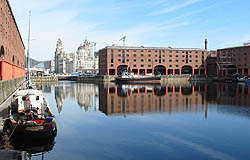 Albert Dock, Liverpool
Albert Dock, Liverpool The Merseyside Maritime Museum, in former warehouse premises at Albert Dock, deals with emigration and immigration, warfare and trade, and maritime art and design: in acknowledgement of an integral element of this story, the International Slavery Museum is housed within the main building. The Museum of Liverpool at the Pier Head is newly built and newly opened, focusing more on the urban-industrial development and social history of the city: highlights include a permanent exhibition on the Liverpool Overhead Railway, which ran for seven miles on viaducts along the docks.
The peak of North Western industrial power was also marked by deep rivalry between Manchester and Liverpool, both civic and commercial: this had its upshot in the digging of the Manchester Ship Canal to free the inland city of dependence on its historic port. Deep enough to float ocean-going ships, the canal tracks along the south side of the Mersey Estuary before running across country, 58 kilometres in all, to the docks at Salford: the officially designated “Port of Manchester”, however, covered almost the whole length of the Canal, with further freight transhipment and production sites along the route. Manchester Ship Canal cruises offer a leisurely way to view this unique combination of rural and industrial landscape from the water.
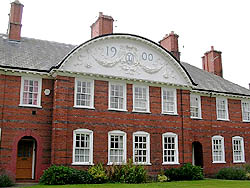 Buildings at Port Sunlight
Buildings at Port SunlightEven before the coming of the Canal, the Wirral Peninsula, across the Mersey from Liverpool, was home to a growing range of chemical and mineral industries. Notable legacies of this development include Port Sunlight, the model “garden village” developed from the late nineteenth century for the workers of the Lever Brothers (later Unilever) soap plant. Ellesmere Port, a major chemical production centre alongside the Canal, has the National Waterways Museum and a huge collection of canal boats.
Further inland on the Liverpool side, St Helens is still home to the Pilkington glass works; the town’s three centuries of involvement in the industry are commemorated at World of Glass, which offers live glassblowing demonstrations.
The West Midlands
If industrial Manchester’s most heated civic rivalry concerned Liverpool, its greatest challenge in terms of global heritage significance surely comes from the West Midland region to the south, whose fortunes were founded not on textiles but on metalware and ceramics. In fact, the conurbation of the principal city of Birmingham with the towns and cities of the “Black Country” – a name suggested variously to derive from the local prevalence of coal or smoke soot – is, by geographical size or population, rather larger than Greater Manchester. And yet the region’s best-known emblem of industrial change, internationally iconic since the eighteenth century, stands over 20 kilometres beyond the western fringes of this conurbation, in predominantly rural Shropshire.
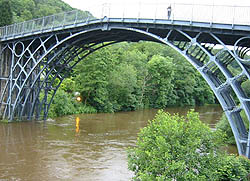 The Iron Bridge
The Iron BridgeIt was at Coalbrookdale that Abraham Darby, founder of the ironmaster dynasty, set up his coke-fired blast furnaces and foundry in 1709; and where his grandson, also Abraham, cast the Iron Bridge – still open to pedestrians today – which the world came to view, giving its name to the village which grew to support it, and eventually to the whole of the gorge on the River Severn it was built to span. Now a UNESCO World Heritage Site, the Ironbridge Gorge presents an unmissable destination for anyone interested in classic industrial change and its modern-day representation. Ten museums, arrayed within easy reach of each other on both sides of the Gorge, tell the stories of the region’s various industries. The Darbys’ works stand preserved as the Coalbrookdale Museum of Iron, while other sites include former ceramic factories (tiles, china ware and tobacco-pipes) and the unique “tar tunnel”, cut through a natural bitumen spring. Best known to general audiences is Blist’s Hill Victorian Town, a “living history” attraction with costumed demonstrators, aiming to recapture the sights, sounds and smells of late nineteenth-century industrial and domestic life.
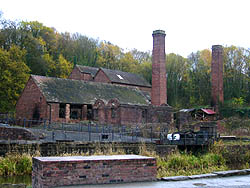 Brick and tile works at Blist's Hill
Brick and tile works at Blist's Hill Returning to the urban centres of the region, “living history” is also on offer at the Black Country Living Museum, Dudley. The Museum is notable for bringing together many nineteenth- and twentieth-century working buildings which have been relocated from the neighbouring towns; yet it also reflects its own past as a site of coal production, lime kilns and rail freight. In the 1980s, the Museum completed the world’s only full-size replica Newcomen engine on the original pattern, which has been undergoing extensive renovation for the 2012 Newcomen tercentenary.
Birmingham has Thinktank, newly built in the science-centre style, but holding the important collections of the city’s former Museum of Science and Industry; the Museum of the Jewellery Quarter, illustrating the city’s role in fine metalworking; and Soho House, Matthew Boulton’s home and meeting-place of the Lunar Society. The famous Soho Foundry of Boulton and James Watt, meanwhile, is still part of a functioning industrial site, belonging to the Avery Weigh-Tronix weighing machine company: the Avery Historical Museum stands on the site (visits by appointment only).
Transport heritage is well represented in the region. The National Motorcycle Museum is at Solihull; further to the east, Coventry Transport Museum reflects the city’s important role in the British car industry, also covering motorbikes and pedal cycles, while the network of canals which crisscross the region – Birmingham, as any trivia enthusiast will tell you, having “more miles of canal than Venice” – has led to sites such as the Galton Valley Canal Heritage Centre.
Within easier reach of Manchester, on the northern fringe of the West Midlands, the Stoke-on-Trent area – still colloquially known as “the Potteries” – was the fiefdom of ceramic masters including Josiah Wedgwood. The Potteries Museum and Art Gallery has extensive ceramics holdings, while the Gladstone Pottery Museum is a complete surviving Victorian site, with the distinctive “bottle-ovens” which once dominated the Stoke skyline. Etruria Industrial Museum – at the settlement named by Wedgwood to recall the artistic inventiveness of the ancient Etruscans – is a former grinding mill whose surviving steam engine is worked on selected weekends.
Further east, another single-industry town of unusual interest is Burton upon Trent, the dominant beer-producing town of Victorian England, where Bass, Allsopp and their rivals brewed for the world. The National Brewery Centre has displays on the town’s heritage and a working microbrewery.
Yorkshire
England’s largest county is a place of contrasts, with a varied industrial heritage: the ancient county town of York, for instance, is home to the National Railway Museum. Only the western division or “West Riding” of Yorkshire, however, underwent the defining process of massive urban-industrial transformation which created modern Greater Manchester and the West Midlands. As in Lancashire, the dominant industry was textile – but with a tendency to the making of finished garments and furnishings, rather than weaving and spinning, and to wool rather than cotton.
Leeds, the largest city of the West Riding, has the Armley Mills Museum on the site of Benjamin Gott’s woollen factory complex, once the largest of the world: the displays now cover the city’s several major industries, including engineering and printing. Bradford Industrial Museum, a former worsted spinning mill, performs a similar role for the neighbouring city.
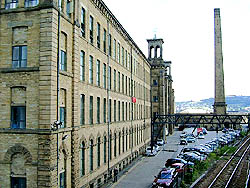 Salt's Mill, Saltaire
Salt's Mill, Saltaire Not far from Bradford – and yet a crucial distance away, in the mind of its maker – is Saltaire, a UNESCO World Heritage Site. This mid-nineteenth-century mill complex and model village was founded by Titus Salt, a major local woollen manufacturer, as an alternative to the Bradford slums. Salt’s Mill now houses a mixture of retail, visitor attractions, and working industrial units; of chief heritage interest, however, is Salt’s superbly preserved model village, with its distinctive stone houses – graduated in size according to the hierarchy of the workforce – and planned civic amenities.
Coal, as in much of Northern England, was also important to the region. Near Wakefield, the former Caphouse Colliery has become the National Coal Mining Museum for England, with deep underground tours and preserved colliery equipment on display.
The area around Sheffield, at the southern end of the old West Riding, turned not to textiles but to steel. The Sheffield Industrial Museums Trust manages the Kelham Island Museum, with collections displays and re-creations of production workshops, plus the Abbeydale and Shepherd Wheel sites, well-preserved examples of eighteenth- and nineteenth-century water-powered grinding and other works.
Cumbria and the Lakes
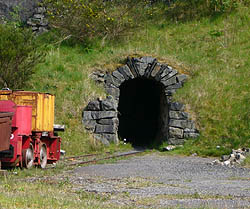 Entrance to the mine at Threlkeld
Entrance to the mine at ThrelkeldFew British readers would immediately think of Cumbria as a promising site for industrial heritage: agricultural and lightly populated compared to the cities and towns of Lancashire to its south, the region is chiefly known for the picturesque Lake District and its tourist-friendly associations with hill walking, the Romantic poets, and Beatrix Potter. As the Visit Cumbria website points out, however, the area’s economy has long depended on a mixture of industries beyond farming – and its strong tourist appeal has ensured their commemoration in a range of visitor attractions.
At Barrow-in-Furness, just beyond the lakes, the Dock Museum, set in a Victorian drydock, reflects the town’s history as a major steel and shipbuilding centre which is still home to submarine production. Mining, historically, was of even greater importance. Haig Colliery Mining Museum stands in a dramatic location above Whitehaven, but the area was significant for the extraction of other materials ranging from granite and slate – Threlkeld Quarry and Mining Museum near Keswick and the Honister Slate Mine in Borrowdale both offer guided tours – to more exotic minerals, some of which were found nowhere else in England. Close to Keswick was also the site of the first known abundant source of graphite, which led to a distinctly localised industry commemorated in the town’s Pencil Museum.
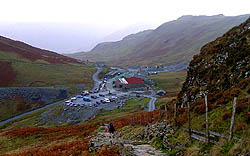 Site of Honister Slate Mine
Site of Honister Slate Mine The region even carries reminders of Britain’s twentieth-century excursions into visionary high technology – though this should be no surprise to anyone who has experienced the frequent sight of a Royal Air Force jet on exercise, screaming in low over the Lakes. The former Sellafield Visitor Centre, near the site of the world’s first commercial atomic power station, is no longer open to the public; but the Solway Aviation Museum owns an Avro Vulcan bomber, the gargantuan delta-winged symbol of Britain’s nuclear-armed postwar prowess, while the Lakeland Motor Museum has collections relating to Malcolm and Donald Campbell, the men responsible for the Bluebird vehicles which claimed a string of land and water speed records.